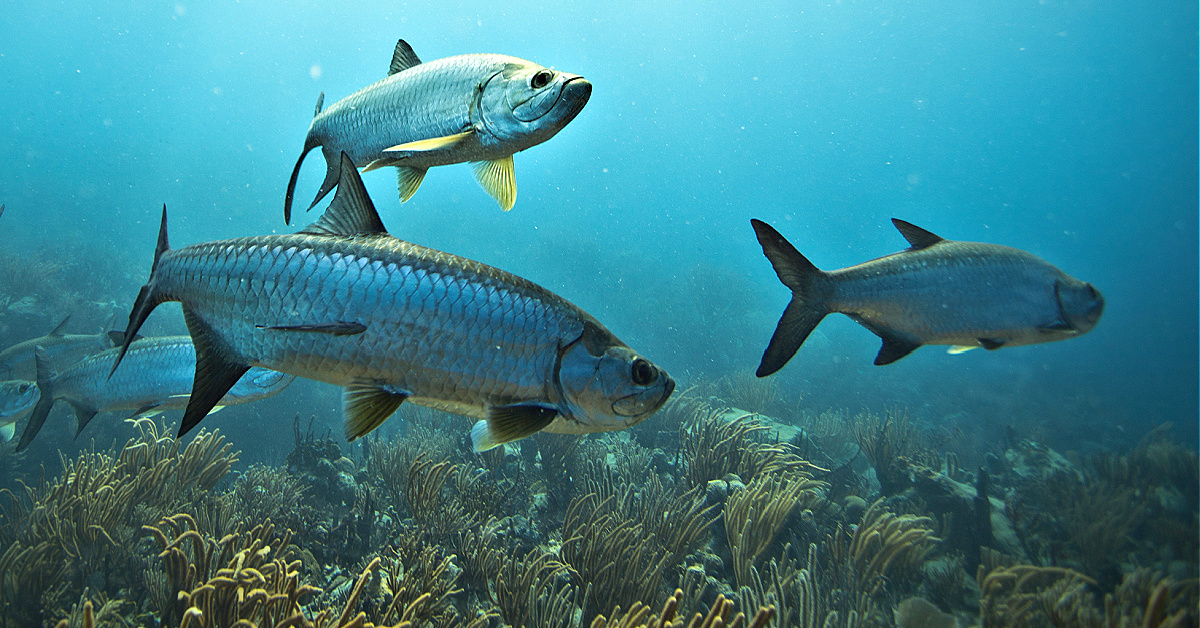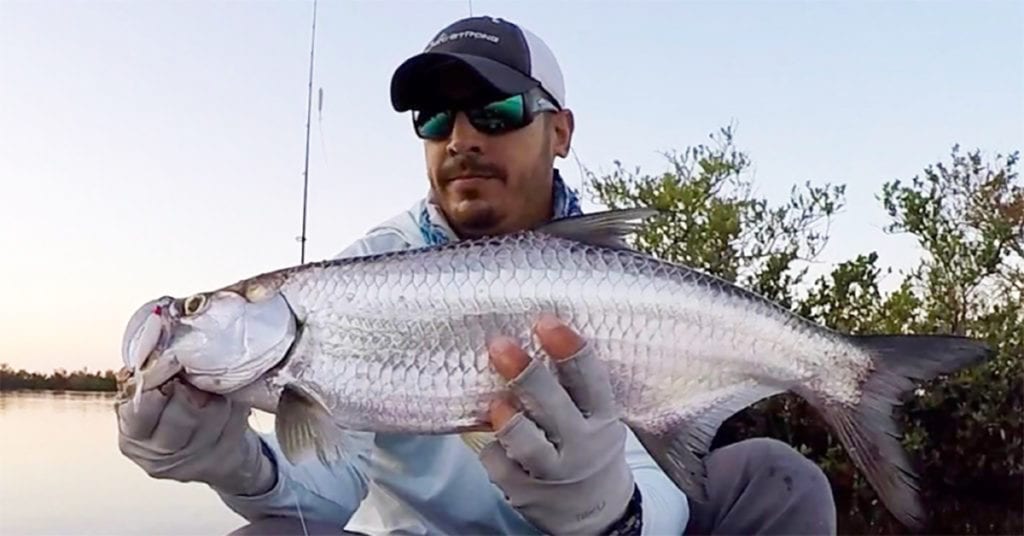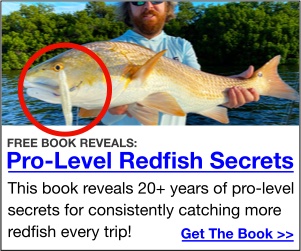The Hunt For Juvenile Tarpon (Everything You Need To Know)
- By: Justin Ritchey
- on

Do you want to know everything about catching juvenile tarpon?
In this video, we break down how and where we target juvenile tarpon.
In this new tea time, you’ll learn:
- Where you can find juvenile tarpon
- The right gear and line to use for juvenile tarpon
- Different lure options
- And much more!!!
Check it out below!
The Hunt For Juvenile Tarpon [VIDEO]

We covered a ton of information so here’s a timestamped version:
- 1:52 – Where you may find juvenile tarpon
- 2:56 – What areas should you specifically look for
- 4:32 – Resident juvenile tarpon
- 5:29 – Differences in appearance between juvenile tarpon and larger tarpon
- 6:10 – Juvenile tarpon school up in the same size range
- 7:09 – Take some time in your fishing area to look for tarpon
- 7:44 – Tarpon food sources
- 8:53 – The best lure to throw for catching tarpon
- 10:16 – Differences when targeting redfish, snook, seatrout
- 10:42 – Tarpon response to lures
- 12:31 – Presentation and retrieve of lures
- 13:09 – Jigheads and weighted hooks
- 14:55 – Pay attention to tarpon behavior (How they are rolling)
- 15:50 – Do tarpon need to come to the surface and breathe air?
- 16:50 – Other lure options to try to catch tarpon
- 17:49 – Tarpon are profile oriented hunters
- 19:01 – Advantages of fly fishing for tarpon
- 20:56 – Instinctual reaction strikes
- 22:58 – Topwater lures
- 25:34 – Leader choices
- 28:46 – Rod choices
- 30:13 – Hook sets
- 31:23 – Fighting juvenile tarpon
- 33:43 – Sweet spot to find juvenile tarpon
Conclusion

Juvenile tarpon can create some awesome, fun action if you hook into one.
It is all about the finesse approach and making sure all of your gear and lures are in order to form the best presentation possible to juvenile tarpon.
Be sure to remember to have your gear sorted and spots picked out because the chaos begins once you hook into these rambunctious fish!
Have any questions about fishing for juvenile tarpon?
Let us know down in the comments!
And if you know an angler who wants to catch more juvenile tarpon, please TAG or SHARE this with them!
P.S. Want access to our best fishing spots and tips, plus discounts to our online tackle store? Click here to join us in the Insider Club
Related Articles:
Related categories:
STOP WASTING TIME ON THE WATER!
Do what the “SMART ANGLERS” are doing and join the Insider Club.
Here’s what you’ll receive today when you join:
- Weekly fishing reports and TRENDS revealing exactly where you should fish ever trip
- Weekly “spot dissection” videos that walk you through all the best spots in your area
- Exclusive fishing tips from the PROS you can’t find anywhere else
- Everything you need to start catching fish more consistently (regardless if you fish out of a boat, kayak, or land).
STOP WASTING TIME ON THE WATER!
Do what the “SMART ANGLERS” are doing and join the Insider Club.
Here’s what you’ll receive today when you join:
- Weekly fishing reports and TRENDS revealing exactly where you should fish every trip
- Weekly “spot dissection” videos that walk you through all the best spots in your area
- Exclusive fishing tips from the PROS you can’t find anywhere else
- Everything you need to start catching fish more consistently (regardless if you fish out of a boat, kayak, or land).










You mentioned that you felt that a more moderate or moderate fast rod would be appropriate. Luke’s article on soft plastics discussed how the moderate rods seemed to be weaker in hook sets with weedless soft plastic baits. My St Croix Avid Medium Fast ( I understand that there is no real standard with respect to action and power) was the very rod that seemed to cause issue. Given the balance between hook set and the juvenile tarpons nature of jumping and throwing the bait what specific rods would you suggest? I’m trying to find the balance.
Great question here, Steven.
Similarly to how Fishing Rods don’t have a standardized “Fast Action” or “Medium Power” in this industry, not all fishermen have the same style of fishing. Luke & I are an Apples to Oranges comparison when it comes to how we present soft plastics, set the hook, etc. He loves to make fun of my “Bill Dance” Hooksets, and I chuckle at his “Wet Noodle” comments when he describes the type of rods I fish with 🙂 It’s all in good fun though.
With that being said, a rod that works well for one type of angler might not work well for another. As I stated, a Medium Power/Fast Action Rod is suitable for most Juvenile Tarpon applications. I mentioned that I tend to prefer softer-tipped rods (which tend to be more Moderate Fast Action) so that I can present those smaller/lighter lures a little more effectively, but that I acknowledge the slight loss of power on the hookset when using those types of rods. Normally I’m throwing lures with an exposed hook to increase my hook-up ratio with Tarpon (weedless soft plastics are not always my Go To when targeting Juvi Tarpon). The trade off I get with a more Moderate Fast Action rod IS that cushion when the fish go to jump & shake the hook out of their mouth—they are less likely to do so, and the softer tipped rod helps serve that purpose well.
It’s more important to make sure you have a strong/sharp hook that connects to a fish first (that’s the #1 priority). A weedless soft plastic presentation might leave you frustrating missing fish because they short-strike the lure, not necessarily because you didn’t get that initial hookset.
I personally believe that your St. Croix Avid Medium Power/Fast Action is perfectly suited for what you’re trying to do (present weedless soft plastics to ANY Inshore Species). Hooking tarpon and staying connected to them is a Love/Hate Relationship! You’re going to miss fish, break them off, jump them off, etc. You just gotta keep at it, Steve! I think there’s more going on here than just the rod itself.
So I already have the answer. Like you said I have to keep trying. Thanks
Luke, fun video! Where and what month would I be able to hire a guide to take me out fishing for juvenile Tarpon? I have put it on my bucket list.
Saturday I had the kayak out fish-watching in my favorite tarpon spot, a saltwater lagoon. The tarpon were feeding furiously on the surface against the shoreline. Today, I was rigged to fish and the 30 inchers were rolling farther out from shore, but not feeding. They wouldn’t hit anything I had, including the 4″ Gulp Swimming mullet and the Bugg tarpon weighted fly. Same time of day, and an hour later, the same tide phase. Cloudier today than yesterday. Any ideas why they feed hard one day and not the next?
Excellent question, Philip. In all honesty, I can’t imagine why they choose to feed more one day than the next. I’m sure we could analyze and come up with several theories, but since conditions were really not that much different from one day to the next, it’s hard to find a smoking gun here.
As I mention around the ~20 minute mark, sometimes it’s about getting an instinctual/reactionary strike, not so much a response based on hunger. Those days can end up being a “Kitchen Sink” approach and swinging for the fences (Tarpon ARE really picky fish). I’ve also had success on a Slam Shady 2.0 with the tail pinched off and on a 1/16oz jig head swimming slowly mid-water column. I think the solution here is really just about persistence for those 1-2 bites, and the bites will probably not be because of hunger.
Thank you Justin. I have to get some 1/16 oz jig heads. I have weedless 1/16 oz pin-grip hooks that I use for shrimp when hunting bonefish in shallow water. I can try those next time I’m out and see if I get a hit. It’s so much easier when they’re actively rushing the bait schools.
I want to recommend using a Ned Rig. An 1/8 red jig head with a Zman white TRD. In late May, in the Keys, there is a small worm that hatches and the Tarpon really go for this. It’s about the size of a TRD and it’s also white and red. I don’t know if these worms are in other parts of FL, but it can’t hurt having a bait that is the same size as the small minnows and the size and color of this worm.
Great idea Jeff! Yes, the Palolo Worm Hatch is a special time of the year down in the Keys, and Tarpon go absolutely insane for those little worms! The TRD in a straight shank hook (without any weight) would probably be deadly for those guys. But I don’t think the Palolo Worm Hatch happens in a lot of other areas throughout Florida (I could be wrong though). I think you’re onto something here!
I’ve found 10-12 pound tarpon in a pool on Duck Key fed by a culvert and they jumped into the mangroves after being hooked and it was so much fun taking my nephews and we fished off of a cleaning dock WooHoo 🙌
Awesome! Tarpon are a blast to hook & catch! Probably made for a great memory for your Nephews!
#64 rubber bands cut into a strip and put on small hank brown jig head. Smallest you can throw. I fish these everywhere and sometimes soak the rubber and pieces in gulp juice. I use 8# braid and 12# fluro. Don’t land the big ones but hook up is way better than a treble hook.
Interesting! Now that’s a finesse approach right there. I’ve heard of people using Plastic Straws to fish for Spanish Macks off the beach, but never rubber bands for Tarpon! How cool. Thanks for sharing this Daniel.
One other comment regarding landing them…. which can be a serious challenge. The fist several I hooked shook the lure on one or two jumps. Even bowing to the King isn’t always enough with rigid braid. Now after hook set I lighten the drag significantly to reduce tension on the jumps … then let them tire out. Works well.
Yes, Bowing to the King is necessary!
Hey a couple comments on tarpon fishing I fish for them off my dock. After they roll they generally go straight to the bottom so it’s critical whatever lure you are using is close to the bottom. I’ve had very good success with Vudu shrimp as well. It’s very much sight fishing. Need to cast on their nose. Of course nothing beats live bait in my opinion…. they will go out of their way for that
Best Greg
There are times that even Live Bait won’t entice a strike from these picky critters (in my experience). But I do agree with you & Tony that there are also times that these fish will not feed directly on the surface. Each day is different with these fish, and it takes a versatile angler to figure out how to dial them in. GREAT intel here Greg, Thank you!
I love fishing for tarpon! I have a few pointers to share. I fish east central Florida like Tony. One thing I would add about location is that if you find them active in a shallow area they are more likely to eat. Also tarpon is one fish that I will throw a bunch of different lures at. I have caught them on a ton of different lures. To many to list hear. If I have actively rolling fish and don’t get a hit on something fairly quick then I switch it up. Sometimes just changing colors can make them bite. I do have some go to lures though. My number one lure is a Rapala Twitching Rap, unfortunately they do not make it anymore. Its a balsa wood lure with no rattles. I truly believe that tarpon prefer lures that don’t rattle. I’m still looking for a replacement for this lure. My second favorite lure is DOA’s Terror Eyz in the regular and tiny sizes. Rootbeer and purple for colors. These things straight up catch tarpon of all sizes. My favorite top water is a Heddon tiny Zara Spook. Its smaller than the Jr and does not rattle. I agree with Justin on the MirrOlure’s MirrOdine. When fishing it though I have had my best luck by using a straight even pull and pause then repeat. Another great bait is a live shrimp tail hooked and retrieving with a straight even pull and pause then repeat.
P.S. If you fly fish they are a great target and love to eat a verity of flies. One of the best is a Gurgler.
Love it, Ron! I’ve thrown the Kitchen Sink at these fish over the years, and I’m always interested in throwing different lures at them to see how they compare to my successful tools.
Spooks, MirrOlure Top Dogs, Rapala Skitterwalks, and all of the walking baits can be kept in nearly the same place without moving it forward, thus keeping it in the strike zone very long if you are working it correctly. Just twitch the rod tip sharply, but end with the rod tip back at the lure. The lure will walk in nearly the same spot. Use braid vs. mono, since mono stretches and acts like a rubber band. When the line stretches it wants to come back to the same length, thus propelling the lure in a forward motion. You can still do it with mono but it takes a little more finesse.
Good intel here, Ray. Thanks for sharing this with the Group.